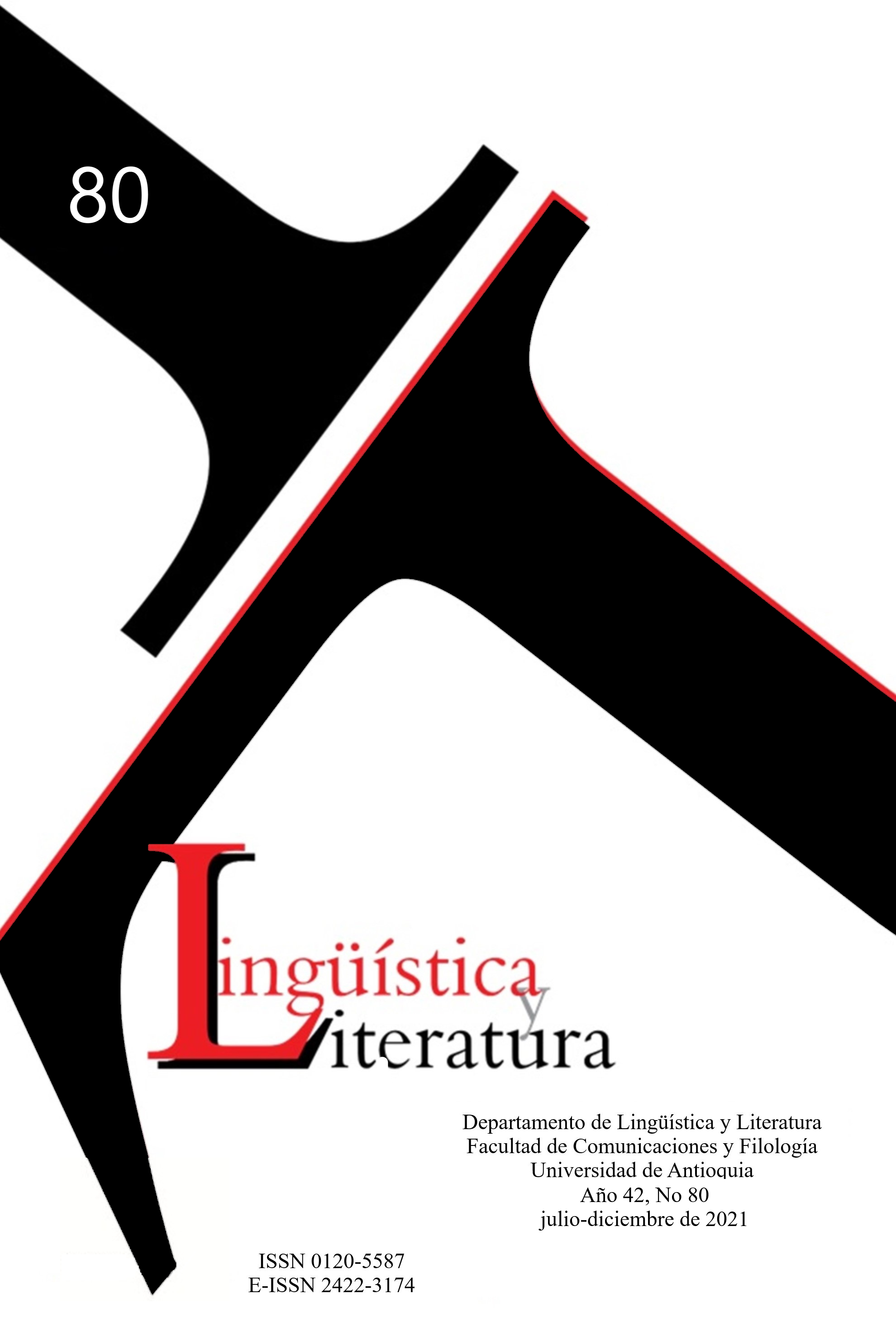Molecules and Postporn in Testo yonqui. A Literary Reading of Paul B. Preciado
DOI:
https://doi.org/10.17533/udea.lyl.n80a10Keywords:
Paul B. Preciado, chronicle, cyberculture, postporn, information epistemeAbstract
The following work constitutes a reading from the literary studies of the experimental essay Testo yonqui, by Paul Preciado. Certain areas of this work can be understood as a chronicle by emphasizing the problem of alterity: a molecular other (testosterone), a loving-sexual other (Virginie Despentes) and an existential other (the death of his friend Guillaume Dustan). In this sense, we will argue that the generic productivity of the work is played as a singular resolution of the interaction between literate culture and cyberculture.
Downloads
References
2. Blanco, A. (2020). Literature and Politics in the Later Foucault. Boston: De Gruyer.
3. Brassier, R. (2017). El prometeísmo y sus críticos. En A. Avanessian y M. Reis (Eds..), Aceleracionismo. Estrategias para una transición hacia el postcapitalismo (pp. 201-220). Buenos Aires: Caja Negra.
4. Butler, J. (1997). The Psychic Life of Power: Theories in Subjection. Stanford: Stanford University Press.
5. Cassin, B. (1994). Nuestros griegos y sus modernos. Estrategias contemporáneas de apropiación de la Antigüedad. Buenos Aires: Manantial. 6. Conde Arroyo, P. (2019). El género narrativo de Testo yonqui. Aproximación a la deriva ensayística de Paul B. Preciado. Artes del Ensayo, 3, 191-214.
7. Deleuze, G. (1991). Posdata sobre las sociedades de control. En C. Ferrer (Ed.), El lenguaje literario (pp. 19-24), Montevideo: Nordan. 8. De Rosso, E. (2012). La línea de sombra: literatura latinoamericana y ciencia ficción en tres novelas contemporáneas. Revista Iberoamericana, 78(238-239),311-328.9. Foucault, M. (2018
[1983]). Una introducción a la vida no fascista, Revista de Frente.http://revistadefrente.cl/michel-foucault-unaintroduccion-a-la-vida-no-fascista-prologo-al-anti-edipo/.
10. Gelman Constantin, F. (2019). Formas de lo viviente en América Latina (1980-2018). Incursiones literarias en una escena biomédica [Tesis de doctorado, Universidad de Buenos Aires]. 11. Haraway, D. J. (1984). Ciencia, cyborgs y mujeres. La reinvención de la naturaleza. Madrid: Cátedra.
12. Hester, H. (2019). Xenofeminismo. Tecnologías de género y políticas de reproducción. Buenos Aires: Caja Negra.
13. Mendoza, J. J. (2011). Escrituras past_ Tradiciones y futurismos del siglo xxi Buenos Aires: 17 Grises.
14. Montes, A. S. (2013). Políticas y estéticas de representación de la experiencia urbana en la crónica contemporánea. Buenos Aires: Corregidor.
15. Mosquera, M. E. (2020). Antropogenética del arte y la literatura. Interferencias entre estética y filosofía de la técnica. Estudios de Teoría Literaria, 9(18), 178-191.
16. Preciado, P. (2014 [2008]). Testo yonqui. Sexo, drogas y biopolítica. Buenos Aires: Paidós.
17. Preciado, P. (2019). Un apartamento en Urano. Crónicas del cruce. Barcelona: Anagrama.
18. Rodríguez, P. (2019). Las palabras en las cosas. Saber, poder y subjetivación entre algoritmos y biomoléculas. Buenos Aires: Cactus.
19. Schaeffer, J. (2001). Les genres littéraires d’hier à aujourd’hui. En M. Dambre & M. Gosselin-Noat (Comps.) L’éclatement au genres au xxe siècle (pp. 11-20). Paris: Presses Universitaires de la Sorbonne Nouvelle.
20. Segdwick, E. (1997). Paranoid Reading and Reparative Reading; or, You’re So Paranoid, You Probably Think This Introduction is About You. En E. Segdwick (Ed.), Novel Gazing. Queer Readings in Fiction (pp. 1-37), Londres: Duke University Press.
21. Shannon, C. E. (1948). A Mathematical Theory of Communication. The Bell System Technical Journal, 27(3), 379-423.
Published
How to Cite
Issue
Section
License
Copyright (c) 2021 Lingüística y Literatura

This work is licensed under a Creative Commons Attribution-NonCommercial-ShareAlike 4.0 International License.
Creative Commons by-nc-sa
Those authors who have publications with this journal, accept the following terms:
1. The journal is the owner of the copyright of the articles, which will be simultaneously subject to the Creative Commons Attribution-NonCommercial-ShareAlike 4.0 International License. that allows third parties to share the work provided its author is indicated and its first publication in this journal.
2. The authors may adopt other agreements of non-exclusive license of distribution of the version of the published work (e.g., deposit it in an institutional telematic file or publish it in a monographic volume) provided that the initial publication in this journal is indicated.
3. Authors are allowed and recommended to disseminate their work via the Internet (e.g. in institutional telematic files or on their website) before and during the submission process, which can produce interesting exchanges and increase citations of the published work.










